Apartment renovation is not complete without changes in such an important room as the bathroom. As a rule, tiles are used as finishing materials for the bathroom. However, the installation process is rather laborious and does not tolerate haste. In addition, high-quality tiles are expensive, so if you miscalculate at least something, the cost of bathroom renovation will increase significantly. There are different options for laying tiles in the bathroom, therefore, before starting work, you need to carefully consider the layout technology and calculate the number of tiles.
When choosing a way to design a bathroom, remember that this room, in addition to hygienic functions, also carries an emotional load, since, taking a bath, a person relaxes and rests. And rest should be accompanied only by pleasant impressions. In order for the repair to please you for a long time, you need to think over everything to the smallest detail.
As already mentioned, tile is the most optimal option for decorating walls and floors in the bathroom. Its undoubted advantages include:
- excellent resistance to high humidity and water;
- resistance to sudden temperature changes;
- ease of care, that is, easy cleaning from dirt with detergents.

When choosing a tile for a bathroom, you should carefully consider the manufacturer's brand and other quality indicators of this material. There are a lot of them in the construction market today, so it is quite difficult for a beginner to make the right decision.
As for the tile configuration, everything is clear here. The basic shapes are square and rectangle. It is much more difficult with the choice of texture, pattern, relief and color of tiles. For those who are engaged in styling tile for the first time, professionals advise giving preference to the larger tiles. You should also avoid choosing a complex layout that requires cutting tiles.
Bathroom design options
To begin with, design ideas can be virtually endless. It all depends on your imagination. You can take the basis from specialized magazines, on the Internet or spy from friends. The fact is that a material such as tile allows you to create many different patterns and combinations. Recently, tile manufacturers have begun to produce shaped parts that can be successfully used with almost any combination. As practice shows, it is best to use basic shapes and additional details from one manufacturer when implementing bathroom design ideas, then you do not have to constantly adjust the tile to size, cutting it. The same applies to the color scheme.

Tile arrangement
Not so long ago, the most popular design for decorating bathroom walls was the following arrangement of tiles: the upper part was laid out with light tiles, the lower one was dark, and the border between them was a border. However, this technique is no longer relevant. And if your bathroom is small, then this tile layout is not at all suitable, since it will visually reduce an already small space. Bathrooms in Soviet-style apartments are too small, so you should not use a large number of decorative elements for their decoration, since it is already cluttered with communications, plumbing and furniture.
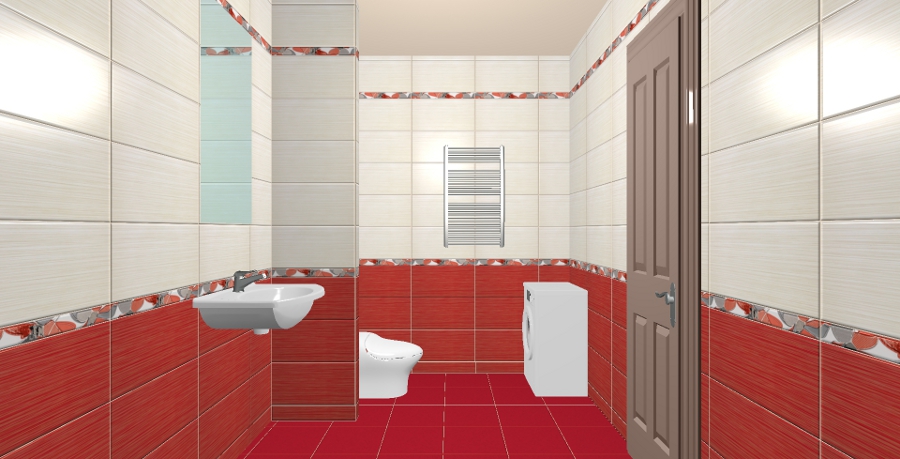
When choosing the color of the tiles, consider your own preferences, since it is you who will have to look at the walls in the bathroom for a long time and their color should not annoy you. Weigh the pros and cons before making a specific decision. Remember that psychologists advise giving preference to calm colors, otherwise you won't be able to relax in the bathroom, too bright colors negatively affect the human psyche.
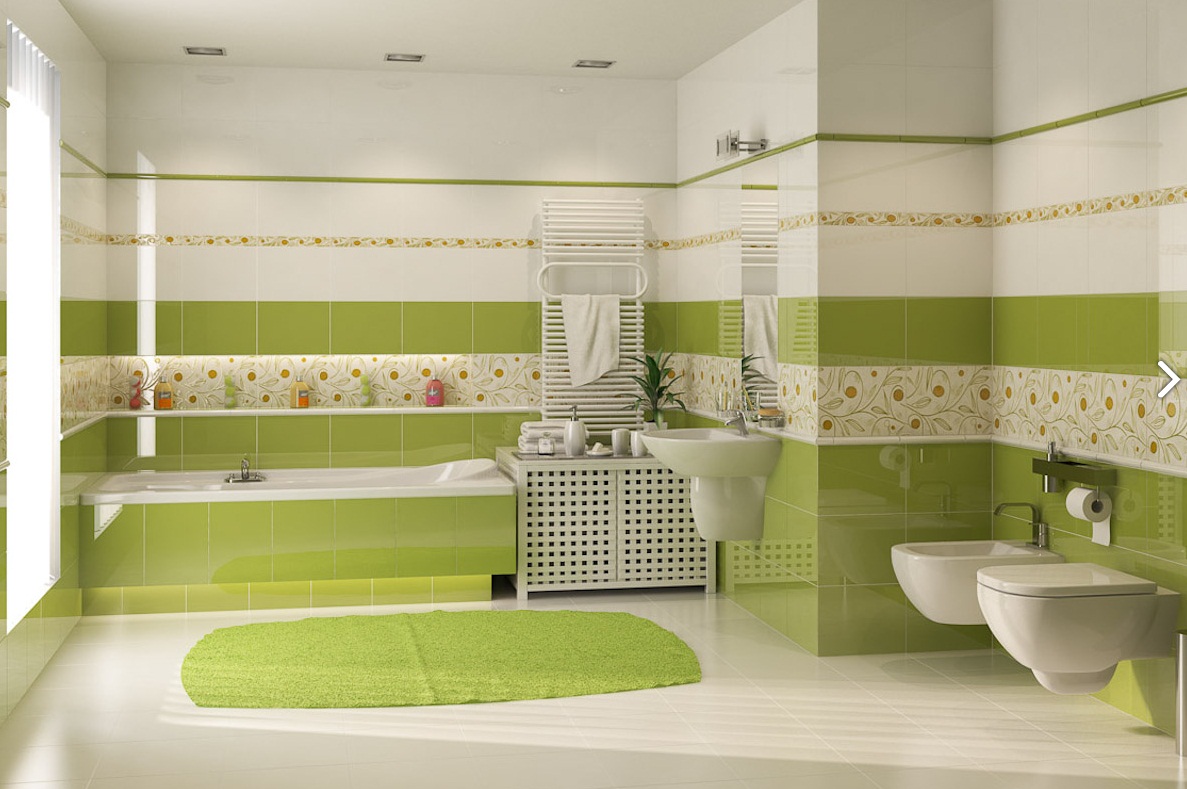
Secrets of styling technology
One of the important tips for beginners is the recommendation to start laying tiles from the wall that completely falls into the field of view of the person entering. Floor centering is practically not used for the bathroom. This is done only when, by design, the center should be highlighted with something brighter than the rest of the area.
If you need to visually increase the height of the ceiling, then the following techniques will help you:
- vertical laying of tiles;
- the use of bright vertical friezes;
- decorative details should be at eye level.

If you want to visually increase the space of the bathroom, then follow a few tips, namely:
- choose medium-sized tiles;
- the tones of the tiles should be cold, that is, blue or silver;
- laying should be done horizontally;
- on the floor, tiles must be placed diagonally;
- the ornament is best to choose transverse;
- curbs should contrast with the bulk of the tiles.
A mirror and a door with a frosted glass insert allow to visually increase the space of the room.
Most modern home improvement stores offer such a service as the selection of bathroom design options using a special program. If you are good at using programs such as Paint or CorelDraw, then you can easily choose your own tile layout options, then future repairs will not seem so difficult. But first of all, you need to create a bathroom design plan.
Making a plan
In order for the tile to be laid out perfectly, you need to draw up a layout plan, for which you need to stock up on a tape measure, pencil, ruler and a piece of paper. Now let's start planning the location of tiles and decorative elements, taking into account the existing plumbing and furniture. So that the cut parts are not striking, it is better to place them in the corners.
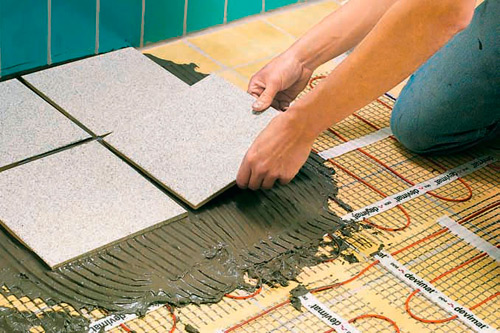
First of all, you need to take the exact dimensions of the bathroom area. Check the measurements taken several times, since the calculation of the flow depends on this finishing material... In addition, it will be necessary to decide in what places the decorative elements will be located and where it is better to lay the cut tiles. The plan should indicate the floor, doors, possible protrusions or recesses. Don't forget plumbing fixtures and lighting fixtures. In addition, it is necessary to indicate the location of electrical outlets and the place of laying communications.
The most popular tile laying methods
Bathroom tiles can be installed different ways... Let's consider the most popular options.
This method is the simplest and involves the layout of tiles in straight rows parallel to the lines of the room. To maintain the verticality of the rows, you should periodically check the correctness of the work using a plumb line. The horizontalness of the rows is checked using a triangle. For this installation method, both square and rectangular tiles can be used. The advantages of seam-in-seam laying are the minimum material consumption, as well as the possibility of using ornaments and borders.

This installation option imitates brickwork, so it is better to choose tiles rectangular... At first glance, a simple technology has some subtleties. For example, you should not use two colors for decoration, because then the surface will look like an uneven one. In addition, laying should be done only horizontally, since vertical rows introduce some dissonance into the interior design. One of the main advantages of this installation method is the ability to use tiles that are slightly different in size. In general, it will not be noticeable.

This method is somewhat more complicated than the previous ones, so it is not recommended for beginners to use it. Laying the tiles diagonally entails a large waste of material, since the tiles will have to be cut into pieces. When laying in this way, the seams take the form of crossed lines, the evenness of which is checked using a triangle.
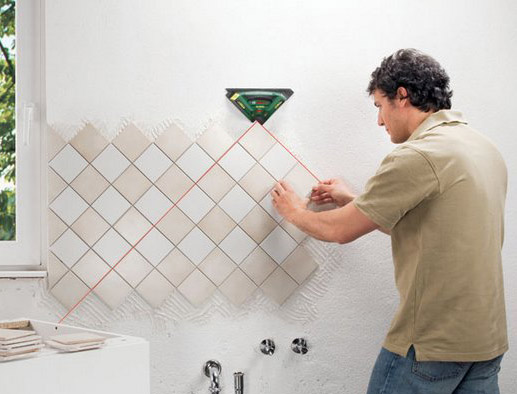
This option is based on the first seam-to-seam method, but using two different tile colors.
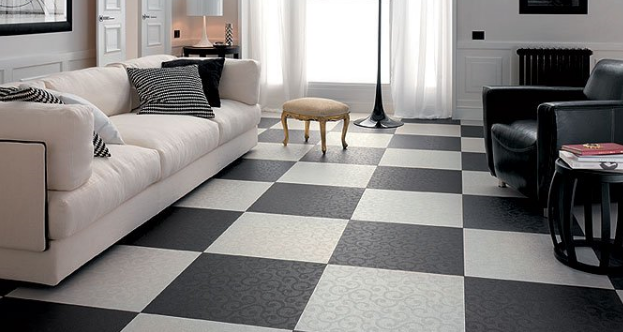
For this method, tiles of several sizes and the same shape are used. Of different tiles a certain pattern is formed that differs from the standard ones. It can represent a specific ornament or a chaotic arrangement of tiles, but in a certain order.

To implement this installation option, tiles of the same size and shape, but different colors, are used. This creates different lines that can be symmetrical, intersecting or broken.
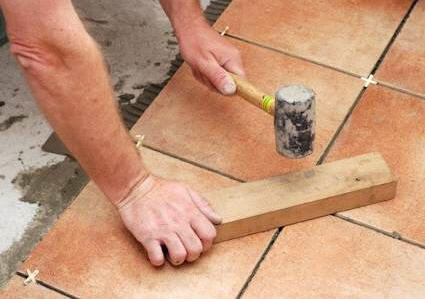
In appearance, this finish resembles a carpet, with a central pattern and a border around the edges. Another option is to carry out a geometric pattern over the entire area with a beautiful border.
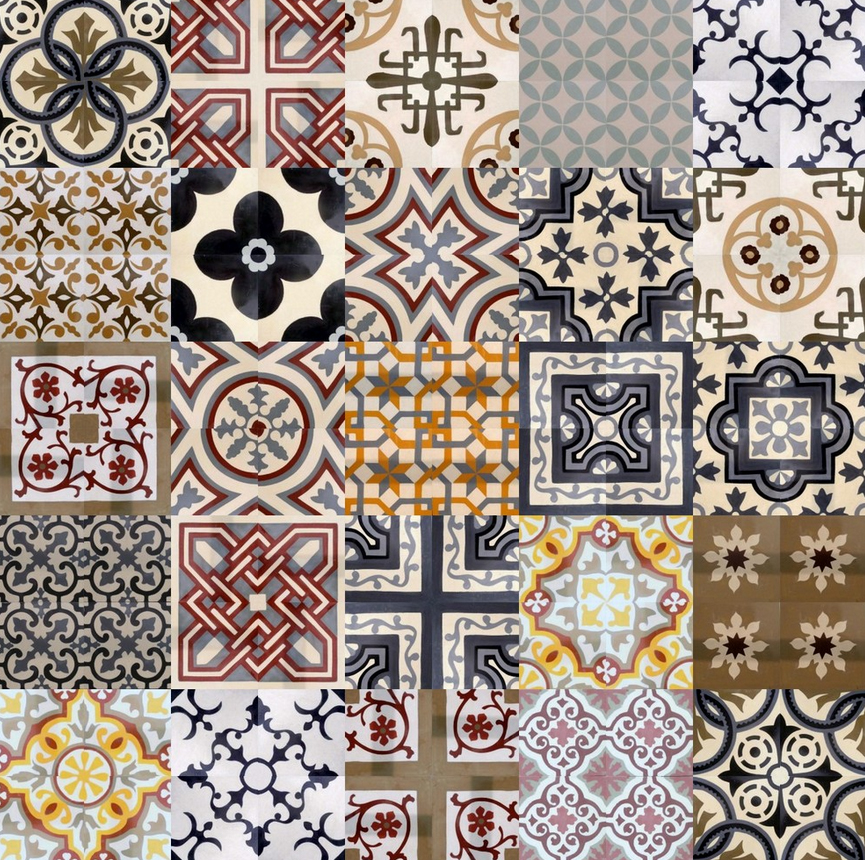
Tiling technology
The tiles are laid in the following order.
- First of all, it is necessary to clean the surface of the walls and floor from old finish, that is, remove the tiles or linoleum.
- Then you should tap the surface and determine the places with a dull sound. If there are any, then it is necessary to remove the plaster or screed, since there may be voids under them.
- The next step is to prepare the surface for laying. In the presence of small differences, the surface is leveled with a cement-sand mortar.
- When the screed is dry, the surface of the floor and walls must be primed and dried well.
- Next, you need to make waterproofing using bituminous pastes or a special mixture for this.
- Now the surface is primed again. If the surface level differences are small, then a self-leveling mixture can be used for leveling, which allows you to eliminate the difference in level up to 15 mm.
- Let's start laying the tiles. You need to start from the far wall and move towards the door.
- Decide where the household appliances and plumbing fixtures will be installed so that the cut tiles can be laid behind them. At the same time, the tiles should be laid from the open corners, where the whole tile is used, to the places where the pieces are glued.
- The laying process is as follows:
- the outer tiles are attached to the wall with alabaster;
- the rest of the tile from the wrong side is moistened with water;
- then the ready-made glue mass is applied to it using a notched trowel;
- on the wall, the tile is glued with a reference point to the tile, which serves as a beacon;
- so that the tile adheres more tightly to the wall surface, it is best to knock on it with a trowel handle;
- the evenness of the laying is checked with a rail;
- excess glue mass is removed immediately with a trowel;
- the seams between the tiles are cleaned with a spatula;
- when the laying is completed, the lighthouse tiles are removed from the wall and attached to it with glue:
- the seams are rubbed last.
The upcoming bathroom renovation most often involves wall and floor cladding. ceramic tiles... It is difficult to argue with such a choice, because it is this material, like no other, that is suitable for high-quality finishing of premises with high humidity. The appearance of the coating is no less important in terms of functionality, and here ceramics are also at their best: the options for laying tiles in the bathroom are striking in their variety. You just need to choose the most suitable one and get down to business.
You can find many ideas for decorating a bathroom, just open specialized or glossy magazines, and also go through the sites. However, common sense should be followed when choosing a design option. Too fanciful and complex finishes may not live up to expectations and the money and effort invested in it. It is best to choose a fairly simple but interesting option. Moreover, tile manufacturers offer a variety of serial products, including shaped parts and basic elements in various colors that are perfectly combined with each other.
Important: If you intend to lay several types of tiles, it is best that they all come from the same manufacturer. This avoids sizing problems.
Before going to the store for material, you should, having studied the examples of laying tiles in the bathroom, draw up a small design project. It will help you to correctly position the tiles and place the elements and accents of the decor so that they are not obscured by furniture, plumbing equipment or shaded. It is also worth considering in advance the location of the cut-off elements, which should, if possible, be installed behind furniture or in the far corners.
A sketch of the bathroom design will help not only calculate the required amount of materials, but also decide on the design of the room
To complete the project, we take the dimensions of the room with the utmost precision. We use the resulting values \u200b\u200bto build a drawing of a room and calculate the required amount tiles. On the finished plan, we designate the shape, size and location of plumbing fixtures, pipe exit sections, taps, sockets and other equipment. Color pencils for different tile layouts in the bathroom. This can be a solid surface, perimeter lay or segments around plumbing or furniture. From the resulting sketches, it is much easier to select the desired option.
Cladding laying methods
There are many tile layouts. All of them can be conditionally divided into three groups.
Classic horizontal laying
Three main options are usually considered here:
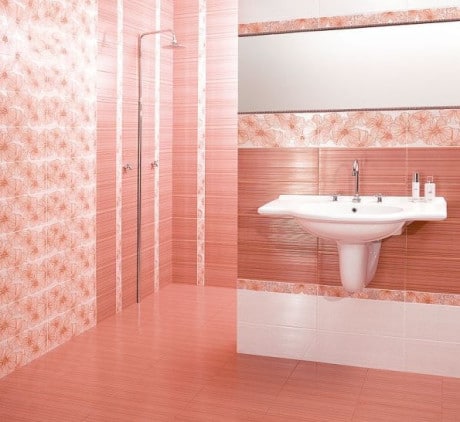
Classic vertical options
Considering the various ways of laying tiles in the bathroom, one cannot fail to note the following techniques:
- Zoning with a panel "with a transition" or decors. A very effective way to draw attention to a specific area of \u200b\u200bthe room.
- The dark shade is located in the corners of the room, the lighter one - in the middle of the wall plane. Decors or borders are used to change shades. Visually "pulls" the wall up.
- For zoning a room, tiles that are completely different in format and color are used.

Effective vertical stacking visually "pulls" the room up
Combined bathroom tile layout
Used to create a spectacular, memorable interior. Like the methods already discussed, the method has several options:
- Various combinations of vertical and horizontal stripes. In this case, instead of expensive decor and borders, tiles of a different color or format are used. The combination of decorative stripes can be absolutely anything, while it should be borne in mind that the vertical ones visually "raise" the room, and the horizontal ones expand.
- Diagonal laying. Allows you to completely abandon additional decor, which makes it possible to save money, and at the same time get an unusual, but attractive surface.
- Combination of vertical and horizontal tiling. Using this method and applying multi-colored grout, you can get a very effective result.
- Inversion method. Assumes the "penetration" of one type of tile into another. The decor can be placed in a certain order or completely chaotic. The inversion method allows you to highlight the desired areas in the room with color.
- Ornament. The original layout of the tiles in the bathroom in the form of various images. It can occupy the entire plane to be decorated or only its part.

Inverted styling allows for a chaotic arrangement of decor or requires a strict geometric sequence. In any case, an effective solution is obtained.
Basic tile layouts
Regardless of which of the laying methods is chosen, the layout method should also be considered. There are also many of them. Consider several ways that are considered classic:
- Base
It involves laying the tiles in simple rows exactly one under the other, parallel to the corners and walls. The resulting drawing resembles a sheet of a notebook in a cage. The simplest and most economical option.
- Bandaging or running
The cladding is laid in horizontal rows, with each subsequent one shifting relative to the previous one by half the tile. This is a rather attractive layout of tiles in the bathroom, the photo of which resembles brickwork. Preferred when installing uncalibrated cladding.
- Diagonal
The first row begins with diagonally cut plates, which are laid in such a way that the tile joints are perpendicular and at an angle of 45 ° to the walls. Installation must be carried out very accurately, which is constantly monitored by a square and a level. The diagonal method produces a very large amount of waste.
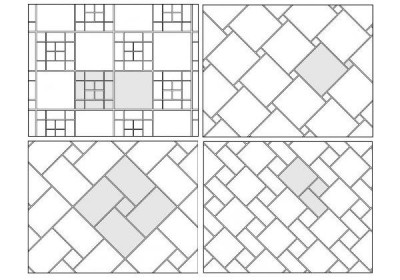
Sophisticated modular layouts require precise dimensional matching of elements
- Module
Tiles of at least three standard sizes are laid out in a special order. Its sides must be multiples of each other, so that you can lay out the drawing from certain blocks. For such installation, it is best to use cladding with a special “modulare” marking, which assumes strict dimensional compliance.
There are many options for laying cladding. Almost every one of them can be used in "pure" form or in some way combined. If it is difficult to determine which tile layout is required in the bathroom, online consultants on specialized sites will help you make a decision. Alternatively, you can consult with specialists involved in the design and installation of cladding. No matter how simple it may seem to decorate a bathroom, many important "little things" on which the impeccable appearance of the room depends are known only to professionals.
If you want your bathroom to look original and unusual, you should take advantage of the modern developments of designers. There are enough materials on the market for you to create a true masterpiece in your bathroom. Tile is a very common material in the bathroom. Tile laying options are different. You can create a design that you and your guests will definitely like. The tiles can be laid both on the floor and on the walls. Below we will consider the most commonly used methods of installing tiles in the bathroom.
This design can be called classic. Manufacturers offer finished projectsso almost every craftsman uses them. This design is attractive because you don’t have to think about how best to arrange the material. You don't even need to calculate the amount of material.
All that will be needed is just to provide the dimensions of your bathroom to the seller, he will determine the required amount of material.
This mounting option has its own distinctive features. Decorative elements and a horizontal strip of frieze can visually narrow the room very much. Horizontal strip of frieze. So if you use this technique in a small bathroom, the room will shrink even though white color material.
So it is better to design with vertical frieze stripes, and not horizontally. For example, in the center of the wall where the bathroom is installed, you can make a vertical strip. You can also highlight the area with a washbasin. In any case, wherever this decor is located, the space will decrease. Here is a photo of this type of styling.
 Select an area with a washbasin
Select an area with a washbasin
This method is used very rarely today. This is due to the fact that the cladding technology is rather complicated. Not all craftsmen manage to lay the tiles in this way, not only correctly, but also beautifully. The main difficulty of the method is to properly markup.
It is also very important to get started right. It is difficult to lay out the diagonal perfectly evenly, especially if the master does not have the necessary experience. can be both on the floor and on the walls. Has its own peculiarity and design of this type of styling. The diagonal seam mesh visually expands the room. The height of the bathroom also increases. The only thing is that you will have to abandon the use of the frieze.
After all, he makes clear accents, so the visual perception of the room will no longer be the same. You can make the wall pattern more varied. Vertical zigzag stripes of tiles that are similar in structure and tone. It's important not to overdo it. One of the most common mistakes when doing this is choosing the wrong landmark.
A marked diagonal is usually used as a guide. But it can serve as an excellent reference point only if the room is square in shape and its walls are even. In order to carry out the layout correctly, it is necessary to abandon the orientation to the diagonal.
It is better to use an isosceles triangle, and to get such a reference point, it is worth setting aside segments of the same size from two corners. They combine to create a wonderful landmark. It is not worth doing work, starting with the installation of cut tiles. After all, after this, the seams can disperse. Below is a photo of this type of styling.
 Diagonal stacking type
Diagonal stacking type Combined styling method: its advantages and disadvantages
This option will only look good in a large bathroom. This method uses both diagonal and. Use different kinds styling is very neat. Otherwise, your bathroom design will turn out to be inharmonious. The easiest way is to create a panel from tiles of various colors and textures.
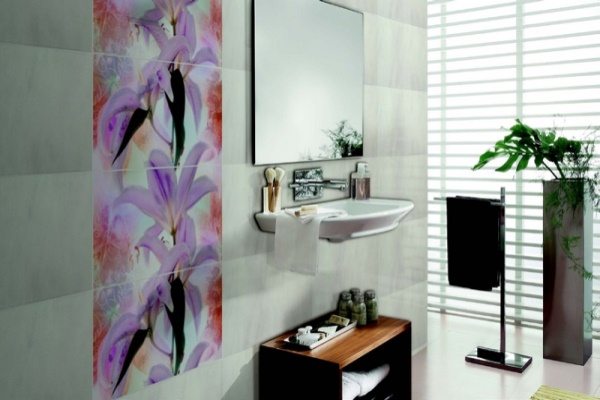 Panels made of tiles of various colors and textures
Panels made of tiles of various colors and textures You can lay out fragments from whole tiles or from cut tiles. In stores, you can buy ready-made kits for mounting such a panel. You will only have a room according to the scheme. This floor will look great. A very interesting option is the method of figured connection of colored tiles.
Technically, this option is very difficult. It will require a special tool that can create curly cuts. You can try to create such a design using a diamond cut. This way you can create a whole puzzle. Your floor will look great. This method will look good in a large room.
You can use various methods of installing tiles both on the walls and on the floor. This will make the drawing even more profitable and attractive.
- A huge number of installation options;
- Saving on repairs;
- Exclusive design;
- Possibility of independent work;
- Rich colors;
- The ability to create visual effects.
Here is a photo of this styling option.
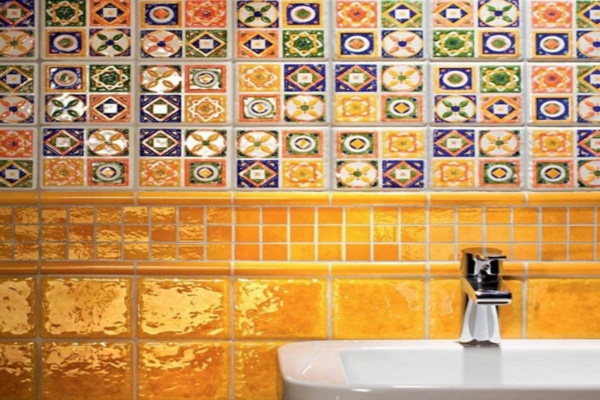 Figured connection of colored tiles
Figured connection of colored tiles
If you decide to use modular laying on the bathroom floor, then you will have to use tiles of different sizes. All of it will be combined into one large module. Such a module may contain a dozen small tiles, or even more.
 Modular styling
Modular styling There are certain types of tiles that can be installed in this manner. This is a whole tile that has been divided into fragments by drawing on it and a separate one. The latter has certain advantages. You will be able to mount the tiles on the floor as you like, using different methods.
If a chess design is being done, a floor or wall that was made in this way looks like a chess board. This method uses tiles of the same size. It can be of different colors. As for the shape, it is better to take a square one. You can achieve a harmonious design even if you use two types of colors or even three. The checkerboard method of installing tiles on the floor can be used both for normal placement and for diagonal placement.
The classical method uses black and white flowers... If you want to experiment, you can rotate the square 45 degrees. Stagger the diamonds.
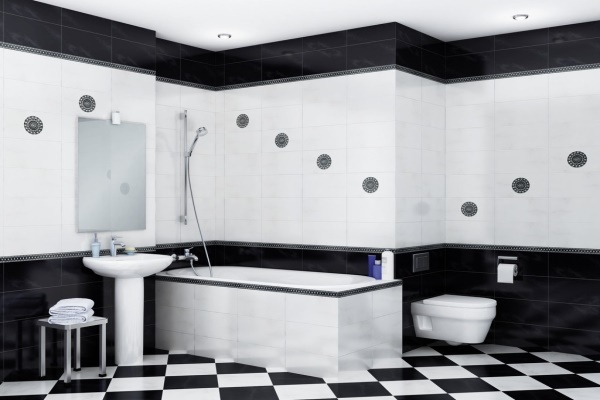 Staggered
Staggered This floor will look very interesting. You can lay geometric patterns, and you can alternate between white and black tiles. The floor, laid on the principle of a zebra, looks very impressive. You can try different types of montage and choose one that suits you.
Keep in mind that if the tiles are parallel to the walls, then this can have a psychedelic effect.
Paul seems very aggressive. Black and white tiles able to revive the room and hide the flaws in the layout. It is undesirable to lay out such tiles at random. An optical effect may occur, making the floor look crooked. For checkerboarding, you can also use contrasting colors, for example, green and yellow. This option will create a good mood.
Video
In this video, you will learn about the different options for laying tiles in the bathroom.
Thanks to this material you will get a lot of useful information.
Photo source: www.moyavanna.com; vannaja.net
Ceramics in bathroom decoration is not losing ground in popularity. It has long ceased to be just a practical option, designers offer such a variety of colors, patterns, sizes and textures that the choice becomes really difficult. Today the TilePol magazine will tell and show you the basic decorative techniques that will help you finally decide what you want your bathroom to look like.
photo from the site https://small-house.ru
Little tricks: how to make the choice of styling easier
The easiest way, which always works, is to invite a professional designer who will produce original ideas, and you just have to choose. If the repair estimate does not provide money for his services, you have to look for ready-made solutions or use your own imagination.
Visualization always makes it easier to perceive, therefore, to imagine what options for laying tiles in the bathroom will suit your taste, draw a diagram:
- Measure the room: the length and height of the walls, the dimensions of window and door openings, the location and dimensions of furniture, plumbing, and mirrors.
- Draw a detailed plan, indicating all items. So you will protect yourself from the fact that expensive decor will be partially covered by a shelf or heated towel rail.
It's great if you have a photocopier at home - several copies of such a plan will come in handy to draw the options you like. This is the only way you can imagine how this or that solution will look in your environment and room size.
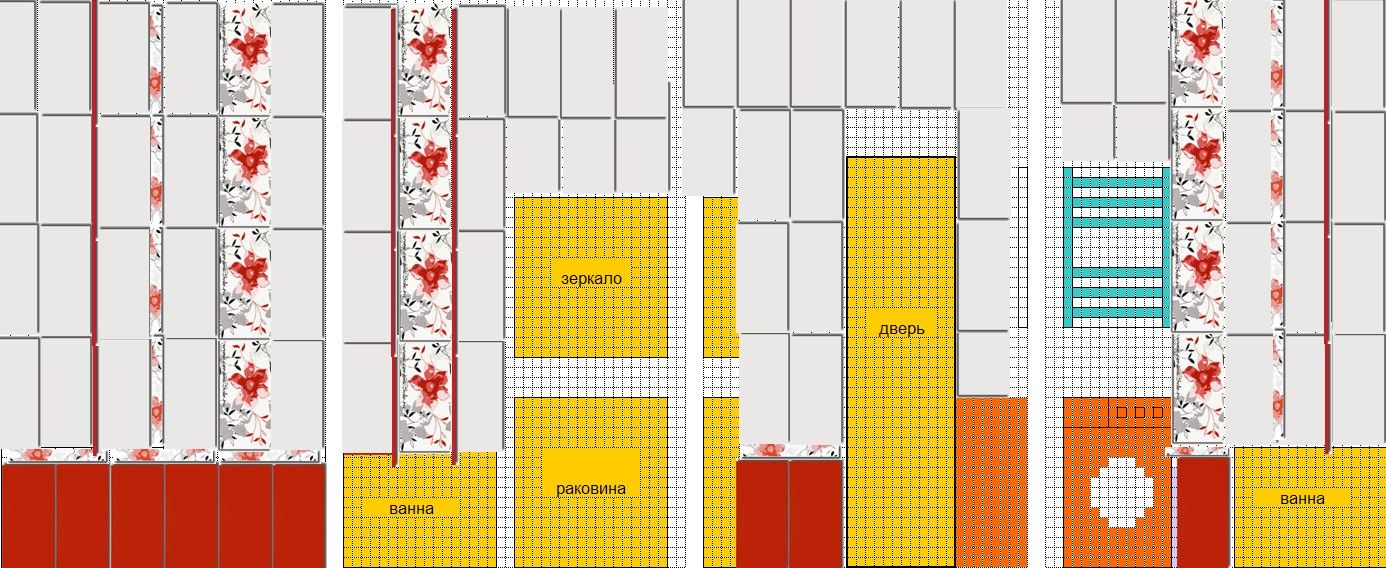
The next step is to choose a color scheme. There are absolutely no standards here, and you should focus only on your taste preferences. The standards and rules that dark colors are not suitable for small baths, and brightness and richness are tiresome, have long been refuted by creative design projects. So if you have long dreamed of diluting the coffee and pastel colors of the apartment interior, then why not do it with a bathroom.
Size matters
Small ceramics or mosaics visually increase the space, but in really large rooms it looks too colorful. Therefore, if the area of \u200b\u200bthe bathroom is large, it is better to allocate only separate sections of the walls for the mosaic.
Tile laying options in the bathroom: photos of successful solutions
There are not so many ways of interposition of tiled elements, and all the diversity is created only through color combinations. Tilers use the following styling options:
- Seam to seam (straight) - the elements are located opposite each other in each row in such a way that the longitudinal and transverse seams of the masonry form perpendicular lines, the direction of which corresponds to the geometry of the room. This is the easiest way, in which it is convenient to control the direction of laying, and beginners should opt for it. Despite the seeming simplicity, straight installation is the best option for interiors in which the emphasis is on color accents.
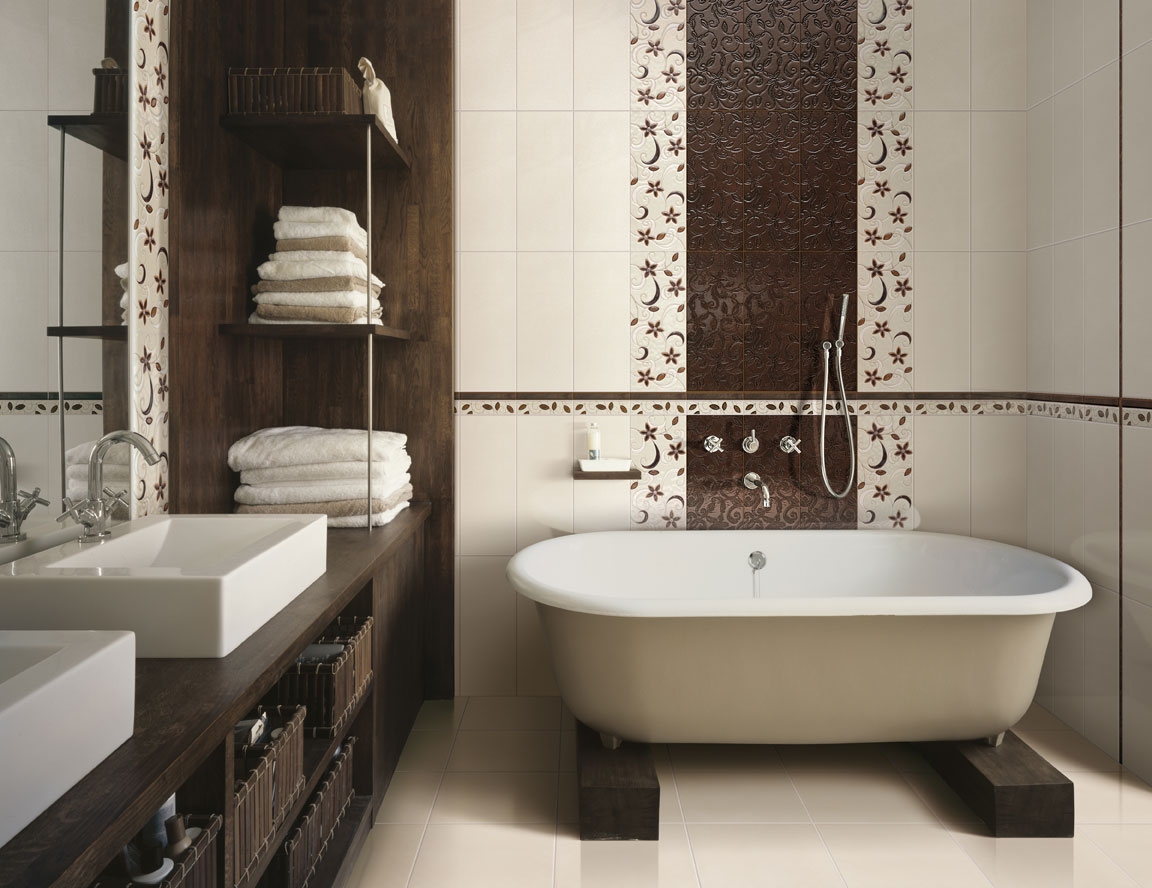
photo from the site http://archset-studio.com
- Diagonal (angular, diamond) - with this method, the seam line is located at an angle of 45⁰ to the direction of the walls. An interesting solution that can visually expand the space and adjust the proportions of the room. Technically a more complicated method, as it requires trimming all elements adjacent to the floors. In addition, the master needs to carefully control the direction of laying. This method makes plain surfaces more interesting.

photo from the site http://dizain-vannoy.ru
- Spreading is a technique in which the transverse seams fall on the center of the tiled element of the previous row. Great for laying small rectangular tiles as it creates a pattern brickwork... Like the first method, staggering is suitable for beginners, as it well hides small errors in the relative position of elements.

photo from the site http://ftono-t.subsider.ru
- Modular - a technically challenging installation involving a combination of tiles different sizes... To simplify the work, you should choose sizes that are multiples of each other, for example, 30x30 and 30x60 cm.

photo from the site http://blocked.triolan.com.ua
There is also artistic styling, in which patterns, ornaments or designs are created from tiles of different colors, but its implementation requires not only the skill of a tiler, but also the makings of a designer.
Design techniques: from classic to non-standard
Ceramic manufacturers today offer collections in which color combinations have already been selected. Most often, within the framework of one collection, the consumer is offered two colors of wall tiles (dark and light), one or two colors floor tiles, borders, decorative elements (with a different texture, pattern or to create a panel).
Horizontal options for laying tiles in the bath
The classic way, in which the border between colors runs horizontally at different heights. This technique can be performed in various ways:
- The lower part of the wall is laid out in a dark color, and the upper part in a light one, with a decorative border laid between them. The gold standard, which is still actively used by those who are afraid of interior experiments. The color transition line should be located just above the washbasin, but if desired, it can be raised even more.
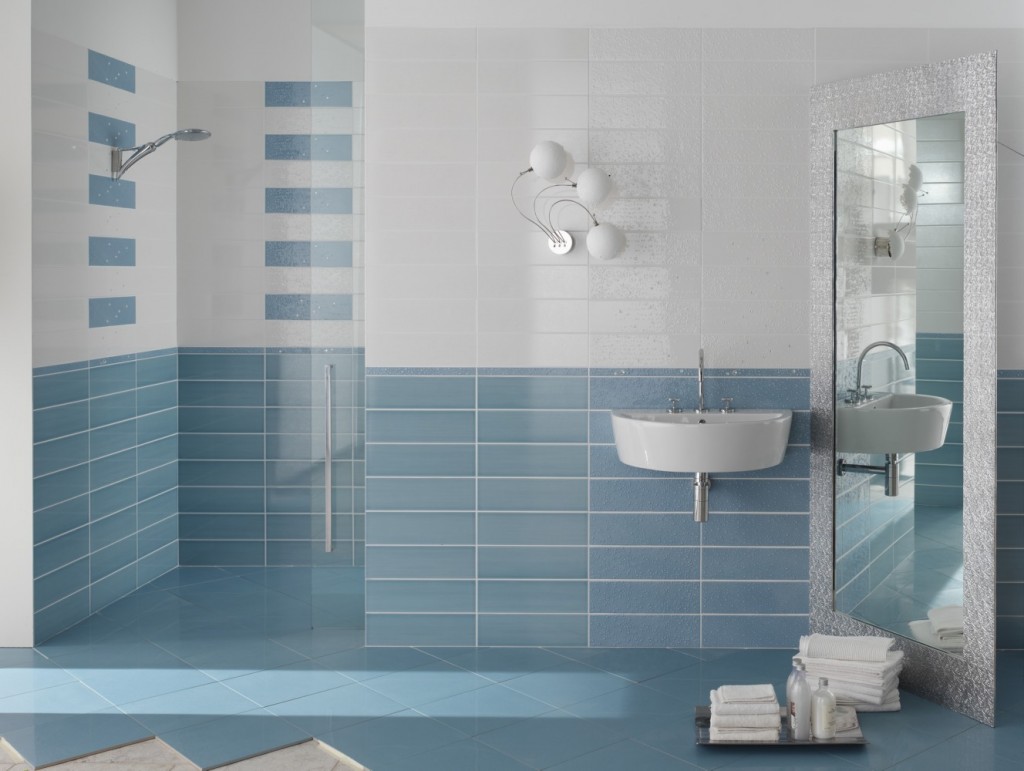
photo from the site http://mirotdelka.ru
- One or two lower rows of wall tiles are laid out to match the flooring, and the top row is to match the ceiling finish. This technique visually expands the space and is ideal for baths in which the height of the room is disproportionate to their area.
- Several horizontal stripes form on the walls. It can be a smooth transition from 3 or more shades from darker to light, or contrasting stripes that visually break the wall into several levels. Like other horizontal options, it is optimal for use in small bathrooms.

photo from the site http://www.o-vannoy.ru
Vertical options for laying tiles in the bathroom
The design created with the help of such an interior solution can be very diverse, but this technique always visually increases the height of the room. Vertical highlighting is used in the following ways:

- Tiles of a different color indicate the area where individual items are located: a toilet bowl, a washbasin or a bath. This is a classic zoning technique in which the strip can continue into the floor cladding.
- The corners of the room stand out with a dark shade. This visually increases the height and pushes the boundaries of the room, especially if the tone of the ceramics matches the color of the floor and ceiling finishes.
- Vertical sections delimit the zones of the decor location. Thus, an emphasis is placed on the decorative areas, drawing attention to them.
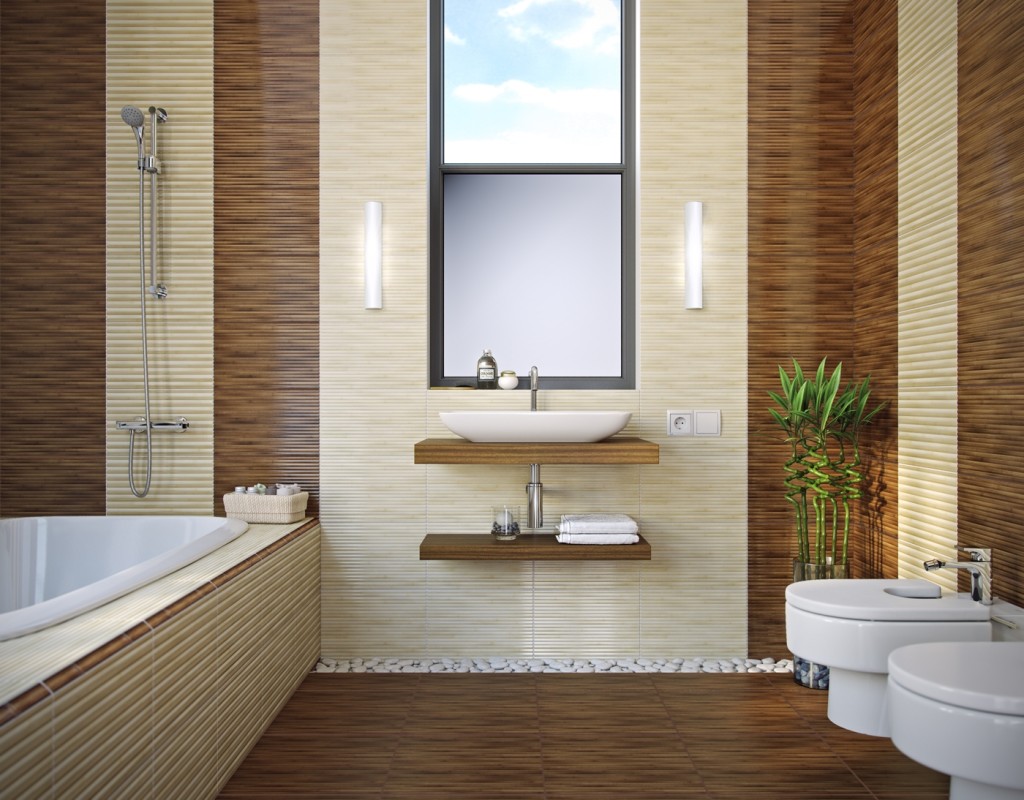
photo from the site http://eto-vannaya.ru
Another option is a combination of vertical and horizontal stripes. When properly positioned, this produces interesting effects, making the interior unique. Horizontal stripes along the floor visually increase its area, while vertical stripes raise the ceiling and create accents.
Play of colors in laying tiles
Plain, smooth plain tiles can become dominant if the colors are positioned in a certain way during decoration. There are no restrictions in this question, but the following methods are most often used:
- Chess. The traditional way to do flooring original - stacking two colors in a checkerboard pattern. Both the classic black and white version and bright combinations will look equally good. Keep in mind that for the floor checkerboard layout, only the seam-to-seam technique is used to avoid visual distortion of the plane.
- Gradient. A non-standard solution with a very interesting color transition effect from lighter shades to dark ones. The transition can also be achieved by interspersed tiles of adjacent shades if a small ceramic format is used. The main difficulty is to choose the material of suitable colors.

photo from the site https://dom.ria.com
- Carpet. The central area is highlighted with a square or rectangle of tiles of a different color, creating a carpet effect. This layout is only suitable for floor cladding of spacious rooms.
- Patchwork. Ideal for interiors in ethnic style, in which all tiles have the same size, but different colors and patterns.
- Kaleidoscope. A cheerful option, in which tiles of different colors are arranged in groups or separately, without a certain pattern. This technique also allows you to save money if you buy leftover material at a significant discount.

photo from the site http://www.remontbp.com
Decor location: noticeable and unobtrusive
If you decide to decorate your bathroom decorative elements, it is worth taking care of their advantageous location. There are many options for arranging decor, so let's focus on the most successful ones:
- Panel. If the manufacturer has provided not just a tile with a pattern, but a real ceramic painting, it is placed on the most open wall. Along the perimeter, the panel can be distinguished with a border or frame of contrasting tiles. It's great if this interior accent is reflected in the mirror.

photo from the site http://vannalife.ru
- Chaotic. Blotches located in some places of the main background will make it less monotonous. Consider the layout so that they are not covered by furniture or a mirror.
- Linearly. A horizontal or vertical strip of patterned tiles can become an interior accent in plain interiors.
Consider the relief
Keep in mind that the location of the embossed elements may interfere with the alignment of the mirror, heated towel rail or furniture. When planning the location of the curbs, try to keep them away from the attachment points.
Subtleties of competent styling
Professional tilers know all the tricks and secrets of their craft. But home craftsmen who make repairs on their own often forget about some of the little things that can spoil the perception of even the most accurate cladding. When deciding how to lay tiles in the bathroom with your own hands, do not forget about the rules for pruning:
- For flooring, whole tiles are placed near the entrance and open walls. Since the glue always starts from the far wall, first lay out the ceramics on the floor, and determine how far you need to cut the first row so that there is a whole tile near the entrance.
- Narrow undercuts should be avoided on walls. If the length of the wall is not a multiple of the size of the tile, and the last section comes out less than 5 cm wide, it is wiser to place wider undercuts in each corner.
- It is better to place whole tiles along the ceiling. Since it is impossible to start laying from above, the first row is trimmed. They begin to glue from the second row, having previously secured the starting bar under it.

photo from the site http://aquagroup.ru
Renovation in the house is a small hurricane, after which not destruction remains, but a beautiful and stylish interior. Our magazine will help you not only to survive this natural disaster, but also to enjoy the process of laying tiles.



